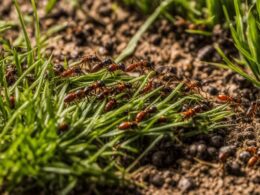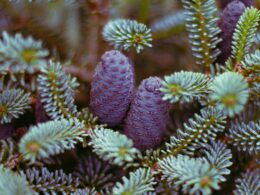Are you considering adding thyme to your herb garden, but wondering if it will come back every year? The answer is yes, thyme is a perennial herb that can survive for several years with the right care.
Unlike annual herbs that need to be replanted each year, thyme will grow and thrive year after year, providing a fresh supply of fragrant leaves for your culinary needs.
To ensure that your thyme plant returns year after year, it is important to understand its growing conditions, planting and care techniques, as well as common issues that may arise.
With the right knowledge and attention, you can enjoy a bountiful harvest of fresh thyme throughout the year. So let’s dive in and explore everything you need to know about thyme as a perennial herb.
Understanding Thyme as a Perennial Herb
Thyme is a perennial herb, meaning it has the potential to last for several growing seasons and is a valuable addition to any herb garden. This herb has been used for centuries in medicine, as it contains compounds with antimicrobial and antioxidant properties. Thyme is also culturally significant, with references to its use in ancient Egyptian embalming practices and as a symbol of courage and strength in Greek mythology.
Because thyme is a perennial herb, it’ll come back year after year as long as it’s properly cared for. It prefers well-draining soil and full sun, but can also tolerate some shade. Regular pruning will help keep the plant healthy and promote new growth.
Thyme can be harvested throughout the growing season and used fresh or dried in a variety of culinary and medicinal applications. Incorporating thyme into your herb garden not only adds a flavorful and versatile herb to your kitchen, but also provides the opportunity to connect with the cultural and medicinal significance of this plant.
With proper care, your thyme plant will continue to thrive and provide a valuable addition to your garden for years to come.
Choosing the Right Growing Conditions
When choosing the right growing conditions for your thyme, there are three key points to consider: soil requirements, sunlight and watering needs, and climate considerations.
Make sure to choose well-draining soil with a pH between 6.0 and 8.0, and give your thyme at least 6 hours of sunlight per day.
Water regularly, but be careful not to overwater as thyme prefers drier soil, and consider the climate in your area when selecting a location for your plant.
Soil Requirements
To ensure a healthy growth cycle, it’s important to provide thyme with the right soil requirements. Here are the top four soil requirements you should keep in mind when planting thyme:
-
Thyme thrives in soil that’s rich in organic matter, so adding compost to your soil can help improve its structure and increase its water retention capacity.
-
Thyme prefers soil with a pH level of 6.0 to 8.0. If your soil pH is too low or too high, it can affect the growth and health of your thyme plant.
-
Thyme doesn’t like to sit in water, so it’s important to plant it in well-draining soil. If your soil is too compact or heavy, consider adding sand or perlite to improve its drainage.
-
Thyme needs at least six hours of direct sunlight each day to grow properly, so make sure to plant it in an area that gets plenty of sunlight throughout the day.
By following these soil requirements, you can help ensure that your thyme plant grows strong and healthy. Remember to check your soil pH regularly and amend it as needed to keep your thyme plant happy and thriving.
Sunlight and Watering Needs
If you want your thyme plant to thrive, you need to know how much sunlight and water it requires. Thyme is a sun-loving plant that needs at least 6 hours of full sun per day. This means that you should plant it in a spot that receives direct sunlight for most of the day. If you live in a hot climate, make sure to provide some shade during the hottest part of the day. On the other hand, if you live in a cooler climate, you may need to provide some extra warmth for your thyme plant, such as a heat lamp or a greenhouse.
Watering frequency is another important factor to consider when growing thyme. While thyme can tolerate some drought, it is important to keep the soil moist but not waterlogged. Overwatering can lead to root rot and fungal diseases that can kill your thyme plant. A good rule of thumb is to water your thyme plant deeply once a week, and more often during hot, dry weather. You can check if your thyme plant needs water by sticking your finger into the soil. If it feels dry to the touch, it’s time to water your thyme plant.
| Sunlight Requirements | Watering Frequency | |
|---|---|---|
| At least 6 hours of full sun per day | Water deeply once a week | |
| Provide some shade during the hottest part of the day in hot climates | Water more often during hot, dry weather | |
| Provide extra warmth for thyme plants in cooler climates | Check soil moisture by sticking your finger into the soil | …and only water when the top inch of soil feels dry to the touch. |
Climate Considerations
It’s essential to understand the impact of climate on your thyme plant’s growth and survival. Thyme is a hardy plant, but it requires specific conditions to thrive. Here are some factors to consider when it comes to climate adaptation for your thyme:
-
Thyme prefers a Mediterranean-like climate, with hot, dry summers and mild winters.
-
If you live in a region with harsh winters, consider growing thyme in a container that you can bring indoors during the coldest months.
-
Thyme can withstand some drought, but it still needs regular watering during the growing season. If you live in an area with low rainfall, consider supplementing with irrigation.
-
Proper winter care is crucial for thyme’s survival. Cover the plant with mulch to protect it from frost, and avoid pruning until spring to prevent damage to new growth.
By understanding your thyme plant’s climate needs and providing proper care, you can ensure that it will come back every year and provide you with fresh herbs for your culinary endeavors.
Can I Expect Rosemary to Come Back Every Year if Thyme Does?
Rosemary perennial plant growth differs from that of thyme. While rosemary is a perennial herb, meaning it can come back year after year, thyme is also a perennial but has a more delicate growth pattern in comparison. So, yes, you can expect rosemary to return annually, but thyme’s growth may be less predictable.
Planting and Care Techniques
When planting thyme, you should wait until after the last frost in your area.
Transplanting thyme can be done easily by carefully digging up the plant and moving it to a new location.
Propagation can be done by taking cuttings from the plant and rooting them in water or soil.
Pruning should be done regularly to keep the plant bushy and productive.
Harvest thyme by picking the leaves as needed throughout the growing season.
When to Plant Thyme
Planting thyme at the appropriate time ensures its longevity and recurring growth. Choosing the best location for planting is crucial, as thyme prefers well-drained soil and full sun exposure. You can plant thyme in the spring or fall, depending on your preference and location.
Here are some tips to help you plant thyme successfully:
- If planting in the spring, wait until all danger of frost has passed.
- If planting in the fall, make sure to do so at least 6 weeks before the first frost.
- Choose a location with good air circulation to prevent fungal diseases.
- Consider trying different thyme varieties to find the best fit for your garden, such as lemon thyme or creeping thyme.
By following these guidelines, you can ensure that your thyme plants will thrive and return year after year. Remember to water your plants regularly and keep an eye out for any signs of pests or diseases. With proper care, you can enjoy the benefits of fresh thyme in your dishes for years to come.
Transplanting and Propagation
Now that you know when to plant thyme, it’s time to learn about the benefits of transplanting and propagation techniques. Transplanting thyme to a new location is a great way to give it a fresh start and promote healthy growth. It’s best to do this in the spring when the soil is warming up, but before the plant starts actively growing. This will allow the thyme to establish itself in its new location without the added stress of trying to grow during the heat of the summer.
Propagation is another way to expand your thyme collection and is often done through stem cuttings. This involves taking a cutting from a healthy thyme plant and planting it in a new location to grow into a new plant. There are also propagation techniques that involve layering or dividing existing plants. By propagating your thyme, you can ensure that you have an abundance of this tasty herb for your culinary creations.
To help you better understand the benefits of transplanting and propagation, take a look at this table:
| Transplanting benefits | Propagation techniques |
|---|---|
| Allows for fresh start and healthy growth | Expands thyme collection |
| Best done in spring | Often done through stem cuttings |
| Establishes thyme in new location | Can involve layering or dividing existing plants |
| Reduces stress on plant | Ensures abundance of thyme for culinary uses |
By transplanting and propagating your thyme, you can ensure that you always have a healthy and abundant supply of this versatile herb. So, don’t be afraid to try out these techniques and watch your thyme thrive!
Pruning and Harvesting
You’ll love learning about how to prune and harvest your thyme to keep it healthy and flavorful for all your cooking needs. Pruning techniques are important to maintain the growth and shape of your thyme plant. Here are some tips on how to prune your thyme:
- Use sharp, clean scissors or pruning shears to cut back the stems.
- Cut back about one-third of the plant at a time, being careful not to remove too much at once.
- Prune your thyme after it flowers to encourage new growth and prevent it from becoming too woody.
Harvesting your thyme is also important for culinary uses. You can harvest your thyme as soon as it starts to produce leaves. Here are some tips on how to harvest your thyme:
- Use clean scissors or pruning shears to cut the stems close to the base of the plant.
- Don’t remove more than one-third of the plant at a time.
- Dry your harvested thyme by hanging it upside down in a warm, dry place.
With these pruning and harvesting techniques, your thyme will continue to thrive and provide you with fresh, flavorful herbs for all your cooking needs.
Common Issues and Solutions
If you’re experiencing problems with your thyme plant, it’s likely due to pests and diseases, nutrient deficiencies, or overwatering/underwatering.
Pests like spider mites and aphids can harm your plant, but they can be easily prevented with proper care.
Nutrient deficiencies can also be treated with fertilizers or adding compost to the soil.
Overwatering or underwatering can be solved by adjusting your watering schedule and ensuring proper drainage.
Pests and Diseases
Thyme’s resilience against pests and diseases make it a reliable herb for any garden. You don’t have to worry much about pests like spider mites, aphids, or whiteflies, as they tend to avoid thyme. In case you notice any infestations, you can prevent them by spraying the plant with a mixture of water and dish soap or neem oil. These natural remedies for pests will not harm the plant and will keep it healthy.
Thyme is also resistant to most diseases, but it can sometimes develop fungal infections like powdery mildew or root rot. To avoid these issues, make sure the soil is well-draining and not too moist. Also, avoid overhead watering and only water the soil around the plant’s base.
If you notice signs of disease, like yellow leaves or white powder on the leaves, you can treat the plant with a fungicide spray or a mixture of baking soda and water. These easy steps will keep your thyme healthy and disease-free.
Nutrient Deficiencies
Don’t let nutrient deficiencies rob your thyme of its full potential; give it the nourishment it needs to thrive. If you notice your thyme plant looking weak or yellowing leaves, it may be a sign of a nutrient deficiency. Thyme needs a balanced supply of nutrients to grow healthy and strong, so it’s important to identify the symptoms and remedies for common nutrient deficiencies.
Here’s a table that outlines the symptoms, causes, and remedies for nutrient deficiencies in thyme plants:
| Nutrient | Symptoms | Causes | Remedies |
|---|---|---|---|
| Nitrogen | Yellowing leaves, stunted growth | Poor soil quality, lack of organic matter | Apply organic fertilizers such as compost or worm castings |
| Phosphorus | Purple or red leaves, weak roots | Low soil pH, excessive rainfall | Add bone meal or rock phosphate to the soil |
| Potassium | Brown or yellow leaf margins, weak stems | Poor drainage, overuse of synthetic fertilizers | Use organic fertilizers like wood ash or kelp meal |
Organic fertilizers are a great option for providing the necessary nutrients without harmful chemicals. With proper nourishment, your thyme plant will have the strength to resist pests and diseases, and produce flavorful leaves for your culinary needs.
Overwatering or Underwatering
Watering your thyme plant properly is crucial for its growth and health, but overwatering or underwatering can lead to serious problems. To avoid these issues, you need to understand the difference between overwatering and underwatering.
Overwatering is when you give your plant too much water, causing the soil to become waterlogged and depriving the roots of oxygen. Signs of overhydration include yellowing leaves, root rot, and a musty odor.
Underwatering, on the other hand, is when you don’t give your plant enough water, causing it to become dehydrated and wilted. Signs of dehydration include wilted and brown leaves, and the soil will be dry to the touch.
To avoid these issues, water your thyme plant when the top inch of soil feels dry to the touch and use well-draining soil to prevent water from accumulating at the roots. By understanding how to properly water your thyme plant, you’ll help it thrive year after year.
Tips for Maximizing Your Thyme Harvest
If you’re a fan of using fresh herbs in your cooking, then maximizing your thyme harvest is essential. Luckily, there are a few tips you can follow to ensure you have plenty of this fragrant herb on hand.
In this discussion, we’ll cover using thyme in cooking, preserving and storing thyme, and companion planting strategies that can help keep your thyme plants healthy and productive.
So whether you’re an experienced gardener or just starting out, these tips will help you make the most of your thyme harvest.
Using Thyme in Cooking
Using fresh herbs in your cooking can add a delicious and aromatic depth of flavor to your dishes. Thyme, in particular, is a versatile herb that can be used in a variety of meals.
Whether you’re using it to add flavor to soup, roast chicken, or even as a topping for pizza, thyme recipes are endless. Not only does it add flavor to your meals, but it also has several health benefits. Thyme is known for its antibacterial properties, which can help boost your immune system and fight off harmful bacteria. It’s also a good source of vitamins and minerals, including Vitamin C and Iron.
When using thyme in your cooking, it’s important to remember that a little goes a long way. Too much thyme can overpower the other flavors in your dish, so start with a small amount and adjust as needed. You can use fresh or dried thyme, but fresh thyme will have a stronger flavor.
To use fresh thyme, simply strip the leaves off the stems and chop them finely. Dried thyme can be added directly to your dish, but it’s best to crush it between your fingers first to release its flavor. Whether you’re using fresh or dried thyme, it’s a delicious and healthy addition to any meal.
Preserving and Storing Thyme
Preserving the aromatic flavor of thyme for future use is easy and convenient, so you can enjoy the herb’s health benefits and delicious taste in your cooking all year round. Thyme preservation is simple and can be done in a few ways.
One of the best techniques is to dry thyme leaves. To do this, gather fresh thyme sprigs and tie them together with a string. Hang the bundle upside down in a cool, dry place for about a week. Once the leaves are brittle to the touch, remove them from the stems and store them in an airtight container.
Storing techniques are also important to keep the flavor of thyme intact. Keep dried thyme in a cool, dry, and dark place, away from direct sunlight. If you prefer to store fresh thyme, wrap it in a damp paper towel and place it in a plastic bag in the refrigerator.
When it comes to choosing between dried and fresh thyme, both have their benefits. Dried thyme is more potent and concentrated, making it ideal for long cooking times and marinades. Fresh thyme, on the other hand, is more delicate and works best in quick-cooking dishes like salads and soups.
Companion Planting Strategies
You can maximize the health and flavor benefits of your thyme by strategically planting it alongside other herbs and plants that complement its growth and properties.
Companion planting benefits not only the thyme, but also the other plants in your garden. For example, planting thyme with vegetables like tomatoes and peppers can help repel pests and improve the flavor of the vegetables.
Thyme also pairs well with other herbs like rosemary, sage, and oregano. These herbs have similar growing conditions and can help improve each other’s health and flavor.
By planting thyme with complementary plants, you can create a thriving garden that not only looks beautiful but also produces delicious and healthy produce for you to enjoy.
Frequently Asked Questions
Can thyme be grown indoors?
If you’re interested in growing thyme indoors, it’s definitely possible! Indoor growing can be a great option for those who don’t have access to outdoor garden space, or for those who want to have fresh herbs available year-round.
Thyme is a great herb to grow indoors because it doesn’t require a lot of space and can be grown in a container. Container gardening is a great way to get started with indoor growing, and you can find a variety of containers that’ll work well for growing thyme. Just make sure your container has good drainage and that you’re using soil that’s specifically designed for container gardening.
With a little bit of care and attention, you can have fresh thyme available right in your own home!
What is the best way to propagate thyme?
To propagate thyme successfully, you’ll need to follow a few simple pruning techniques and prepare the soil properly.
First, ensure that the soil is well-drained and rich in nutrients. You can achieve this by mixing in compost or aged manure into the soil.
Once you’ve prepared the soil, it’s time to prune your existing thyme plant. Cut back the stems by about one-third of their length, which will encourage new growth.
You can also take stem cuttings in late spring or early summer and root them in moist soil.
With the right soil preparation and pruning techniques, you can easily propagate thyme and enjoy fresh herbs year after year.
How long does it take for thyme to reach maturity?
To ensure optimal growth for thyme, it’s important to understand its growth stages. Thyme typically takes about 2-3 months to reach maturity from seed, and can take up to 1-2 years to fully mature.
During its growth stages, thyme requires well-draining soil and plenty of sunlight. It’s important to keep the soil moist but not waterlogged, as overly wet soil can lead to root rot.
In addition, thyme benefits from occasional pruning to promote bushier growth. By providing the right conditions and care, you can ensure that your thyme plant reaches its full potential.
Is it safe to use pesticides on thyme?
Looking for pesticide alternatives for your thyme? Good news! There are many safe and natural options available.
First, consider planting thyme alongside companion plants like marigold, which naturally repel pests. You can also make your own natural pesticide by mixing water and a few drops of essential oils like peppermint or lavender.
Additionally, preserving your thyme properly can help prevent pest infestations. Dry or freeze your thyme to keep it fresh for longer and avoid the need for pesticides altogether.
With these tips, you can keep your thyme healthy and pest-free without compromising your safety or the environment.
Can thyme be used for medicinal purposes?
Thyme tea is a popular choice for those seeking natural remedies for inflammation. It’s believed that thyme has anti-inflammatory properties that can help reduce pain and swelling. To make thyme tea, simply steep a handful of fresh or dried thyme leaves in hot water for a few minutes. Strain the mixture and drink it as is or add a bit of honey for sweetness.
It’s important to note that while thyme is generally safe for consumption, it’s always best to consult with a healthcare professional before using it for medicinal purposes.
Conclusion
So there you have it – thyme is indeed a perennial herb that can come back year after year! With the right growing conditions and proper care techniques, you can enjoy a bountiful harvest of this fragrant and flavorful herb.
Remember to choose a sunny location with well-draining soil, and to water your thyme regularly but not too much. If you encounter any issues such as pests or disease, don’t panic – there are plenty of solutions available.
And if you want to maximize your thyme harvest, consider pruning it regularly and using the fresh or dried leaves in a variety of dishes. With a little effort, you can enjoy fresh thyme in your garden or kitchen all year round!








